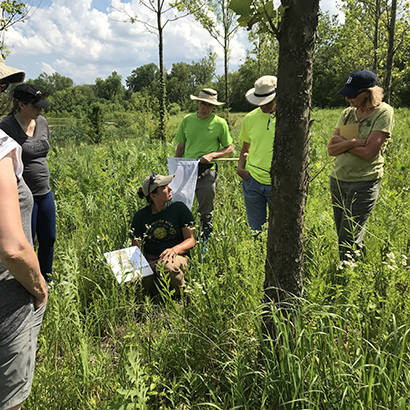
During the month of June, in conjunction with our Parks for Pollinators campaign, NRPA hosted its first-ever national bioblitz, with support from Scotts Miracle-Gro Foundation. Parks for Pollinators focuses on raising public awareness of the current pollinator crisis, encouraging local action, and positioning parks as a national leader in advancing pollinator health. To that end, park agencies and conservation-minded organizations across the country engaged their communities in this month-long, citizen science experience to educate them about the pollinators in their local area and the pollinators’ importance.
More than 180 individuals pledged to help pollinators and downloaded information on how to host a bioblitz. Events were organized from coast to coast, with a total of 21 states being represented and 43 agencies participating. These groups recorded more than 5,000 observations of pollinators and supporting plants and documented more than 1,500 different species. Some 580 people participated to record these findings and 552 experts help identify them on the iNaturalist app.
Nationally, the most commonly found plant species were lemon beebalm, indian blanket and American basketflower and, for pollinators, monarch and eastern tiger swallowtail butterflies and western honey bees. Check out the results, especially to see what pollinators were found near you!
NRPA tagged along with staff from the City of Columbus Recreation and Parks Department and representatives from Scotts Miracle-Gro Foundation and other partners to host a bioblitz at Franklin Park Conservatory’s Pollinator Palooza event on June 22. The park staff led the charge to educate attendees about their local pollinators and help them participate in their bioblitz. The Palooza featured pollinator experts, demonstration tables and many engaging family-friendly activities, which were broadcast on Facebook Live from NRPA.
The learning doesn’t stop with the bioblitz since the information on iNaturalist has a life after the event! That data feeds into the larger research world to help with biodiversity projects. Many agencies are taking what they learned from their bioblitz to inform how they manage their open spaces, as well as to find better ways to engage their community on environmental issues, like the pollinator crisis. Park agencies can also create their own biodiversity indexes for their spaces from the data. Even if you haven’t hosted an event, you can create a guide from the data already on the site (if your area already has data). Simply go to the site, www.inaturalist.org/guides, and create your own guide and find what’s in your parks.
Some Feedback from Texas
A shout-out to our Texas agencies: Five agencies from the Lone Star State signed up to host a bioblitz and three of them were atop the leader board with observations. We caught up with a few of them to talk about their experiences. Dallas Park and Recreation Department ran its bioblitz for the entire month of June, but right before its main event a major windstorm swept across the city. One area alone lost 255 large trees and the surrounding neighborhood was severely affected. Many of the big trees it lost had significant hollows, which are structurally bad for the trees but wonderful for wildlife. From hosting a bioblitz prior to its Parks for Pollinators event, the park agency now has pre- and post-storm data. Brett Johnson, the agency’s senior environmental coordinator and urban biologist, will use this comparison data with future bioblitz information so that his department can understand the changes in species from habitat changes in that specific area.
Fort Worth Nature Center & Refuge held a bioblitz with a pollinator-focused education day, while also dedicating a new pollinator sign! It hosted a bee program, native plant giveaway, a roving naturalist and a morning pollinator hike. Throughout the day, families, community leaders, council members and members of the local Natural Guard (conservation volunteers) were engaged around the importance of pollinators, including the Parks for Pollinators bioblitz!
Georgetown Parks and Recreation had some well-versed blitzers in attendance for its event, as well as some people who did not fully understand what a pollinator was. Because of the diversity of knowledge levels, it was able to divide attendees into smaller groups and allow participants to share their own knowledge with each other (with staff assistance). Through events like this, it hopes to develop a greater understanding of its park’s biodiversity, which will help it address questions about species in the park and help update the master species list.
“It was wonderful to see so many new visitors to the park helping to chronicle some of our species’ diversity,” says Rowan Prothro, recreation specialist for Garey Park, Georgetown Parks and Recreation. “Kids and adults alike were connecting with Garey in a way that they had not before. Watching parents bring their kids out to learn about pollinators was awesome — very inspiring to see a new generation of nature lovers!”
NRPA is collecting stories, images and feedback from all who signed up for this year’s inaugural bioblitz. Send us your stories. We would love to share them, and we hope even more of you will join us next June for round two of the Parks for Pollinators bioblitz!
Michele White, CAE, IOM, is an NRPA Program Manager, Conservation.

